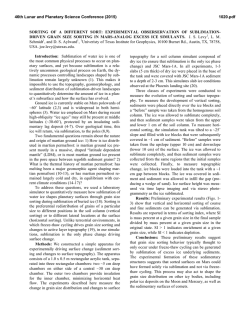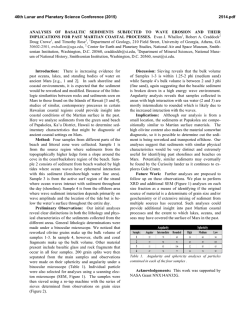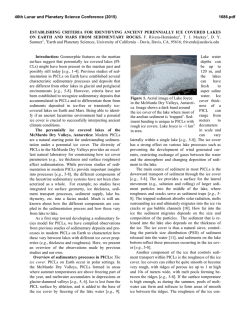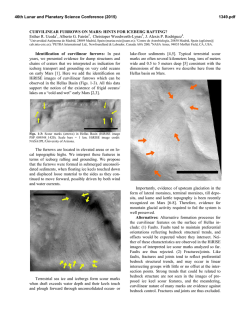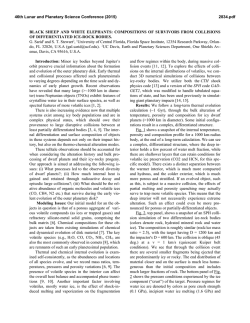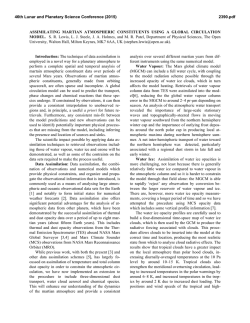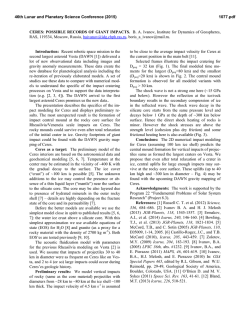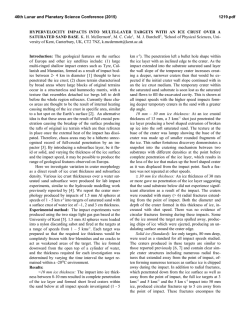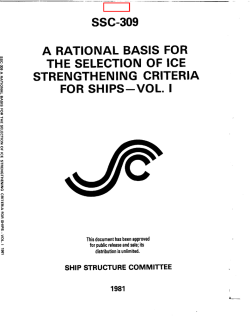
Surface Layer Thermal Inertia Reveals Presence and Depth of
46th Lunar and Planetary Science Conference (2015) 1241.pdf Surface Layer Thermal Inertia Reveals Presence and Depth of Subsurface Ice. S. R. Baker, Mars Outreach for North Carolina Students (MONS), Durham Academy High School, Durham, NC 27705 ([email protected]) Introduction: An important part of the search for current water on Mars is confirming the existence of subsurface ice. Subsurface water ice on Mars has been demonstrated by both extensive modeling – gamma ray and neutron spectroscopy – and direct observation [1][2]. In theory, the depth of subsurface ice on Mars may be estimated by evaluating the thermal inertia of the regolith surface layer, which can be performed remotely [3]. Thermal inertia is a measure a material’s thermal responsiveness to changes in temperature and is defined by the equation: 𝐼≡ 𝑘𝜌𝑐 [J m-2 K-1 s-½] 𝑘 = 𝑡ℎ𝑒𝑟𝑚𝑎𝑙 𝑐𝑜𝑛𝑑𝑢𝑐𝑡𝑖𝑣𝑖𝑡𝑦 [W m-1 K-1] 𝜌 = 𝑏𝑢𝑙𝑘 𝑑𝑒𝑛𝑠𝑖𝑡𝑦 [𝑘𝑔 𝑚 -3] 𝑐 = 𝑠𝑝𝑒𝑐𝑖𝑓𝑖𝑐 ℎ𝑒𝑎𝑡 𝑐𝑎𝑝𝑎𝑐𝑖𝑡𝑦 [J kg-1 K-1] Thermal data from Mars has been collected by THEMIS (THermal EMission Imaging System), an instrument on the Mars Odyssey orbiting spacecraft that measures visual and infrared wavelengths and can demonstrate diurnal and seasonal heating and cooling of Martian sediment [4]. Modeling using thermal inertia data indicates subsurface ice as close as 5 cm from the surface [3]. Because thermal inertia of ice (2176 J m-2 K-1 s-½) is significantly greater than the thermal inertia of sediment (250 J m-2 K-1 s-½) [5], Bandfield hypothesized that ice just a few centimeters below the surface would cause the surface layer of sediment to resist changes in temperature more than sediment with deeper or no subsurface ice [3]. In order to test this theory, an experiment was conducted under controlled conditions to determine whether the thermal inertia measured at the surface is affected by the presence and depth of subsurface ice. Analytical Approach: To test the effect of subsurface ice on the thermal inertia of surface sediment, three different models were created: a control model with no ice, a model with a near-surface ice table, and a model with a deeper ice table. Each model was constructed in an insulated container measuring 25 cm wide by 38 cm long by 33 cm tall. The control model contained 30 cm of sediment and no ice. The near-surface ice table model contained 5 cm of sediment on top of 25 cm of crushed ice, and the deeper ice table model contained 15 cm of sediment on top of 15 cm of crushed ice. For each of these three models, the surface temperature was measured while the surface sediment was heated and then allowed to cool. The sediment samples were heated with a lamp that generated 630 watts per square meter, which closely simulates the 590 watts per square meter experienced by Mars’s surface. An infrared reptile lamp was used because it emits a wide range of energy, including ultra-violet light, similar to the range found on Mars. The temperature was measured using infrared thermometers. The Mars regolith analog used for these experiments was sediment collected from the Eno River in Durham, North Carolina, that was sieved and rinsed to remove observable clay and dust. The samples were then baked to remove residual water. The sediment ranged in diameter from 0.5-1mm (“coarse sand” on the Udden-Wentworth Scale) to 1040mm (“pebble gravel”) because Martian sediment contains a range of particle sizes. The experiment was configured according to the diagram in Figure 1. The temperature of the center of each sample was measured remotely with an infrared thermometer prior to the start of the experiment. The heat lamp was subsequently turned on and temperature readings were recorded every minute for 30 minutes. After 30 minutes, the lamp was turned off, and temperature readings were again recorded every minute for an additional 30 minutes as the sample cooled. At the end of both the heating and cooling phases, the temperature of the sample for each model reached near-stability with temperatures fluctuating within approximately 0.5 oC. For each of the three models, two heating-cooling cycles were performed, and the average temperature at each minute was plotted using Excel (Microsoft Excel for Mac 2011, version 14.2.2). Figure 1 46th Lunar and Planetary Science Conference (2015) Results: As shown in the graph in Figure 2, the temperature measurements for the sediment-only control very nearly match the measurements for the deeper ice table model (ie., 15 cm of sediment over 15 cm of ice). Baseline temperature for the control was 23.2 °C with a maximum temperature of 46.8 °C. Temperature declined to 24.2 °C when the heat source was removed. Similarly, the deeper ice table model had a baseline temperature of 22.5 °C, rose to a maximum of 44.8 °C, and cooled to 23.7 °C. The data and graph confirm that the thermal inertia of the control was nearly identical to that of the deeper ice table model. In contrast, the temperature of the near-surface ice table model rose more slowly, indicating a higher thermal inertia than the control. The near-surface ice table model had a baseline temperature of 21.7 °C and a maximum temperature of only 37.5 °C. Its final temperature was 13.5 °C. Figure 2 1241.pdf Future Works: In the future, a more precise analogue for Martian regolith could be used instead of the coarse sand/pebble gravel mixture available for this experiment. The Martian surface also includes a wider range of grain sizes from fine dust to larger boulders that affects the thermal inertia. For this experiment, the ice table was comprised of pure water ice chips. However, most of the subsurface ice on Mars is a mixture of sediment and ice [6]. In the future, this work could be repeated using varying mixtures of ice and sediment beneath a layer of sediment. The ambient temperature on Mars is, on average, -46 oC. In contrast, the temperature of the lab in which the experiment was performed was approximately +21 oC. Because the ambient temperature has a large effect on the measured surface temperature, the experiment could be performed in an extremely cold environment that better mimics Martian conditions. Acknowledgements: I would like to thank Howard Lineberger, Samuel Fuerst, and Charles Payne for coordinating the MONS (Mars Outreach for North Carolina Students) program. Thanks to Dr. Jeff Moersch of the University of Tennessee, who is conducting similar research to design models to best interpret THEMIS infrared data. Discussion: The results demonstrate that thermal inertia can be used to recognize sub-surface ice, but only if the ice table is within several centimeters of the surface. The rise in temperature of the sediment-only control over the 30 minutes of heating (23.6 °C) was substantially greater than the rise in temperature for the near-surface ice table model (15.8 °C). This difference confirms that water ice within 5 cm of the surface alters the thermal inertia of the surface layer. In contrast, in this experiment, water ice at a depth of 15 cm (deeper ice table model) did not affect the thermal responsiveness of the surface sediment. The heating and cooling curves of the control model and deeper ice table model are nearly identical. There is a slight separating in the heat curves, but this could be due to a lack of controlled variables in the environment. References: [1] Schorghofer N., Forget F. History and Anatomy of Subsurface Ice on Mars. Icarus 220: 1112-1120; 2012. [2] "Confirmation of Water on Mars". Nasa.gov. 200806-20. Retrieved 12-24-2014. [3] Bandfield J.L.. High-Resolution Subsurface WaterIce Distributions on Mars. Nature 447: 64-68; 2007. [4] About THEMIS & the Mars Odyssey Mission <http://themis.asu.edu/about>. Retrieved on 12-242014. [5] Schorghofer N.. Fast Numerical Method for Growth and Retreat of Subsurface Ice on Mars. Icarus 208: 598-607; 2010. [6] Found it! Ice on Mars. http://science.nasa.gov/science-news/science-atnasa/2002/28may_marsice/. Retrieved 12-24-2014.
© Copyright 2025

